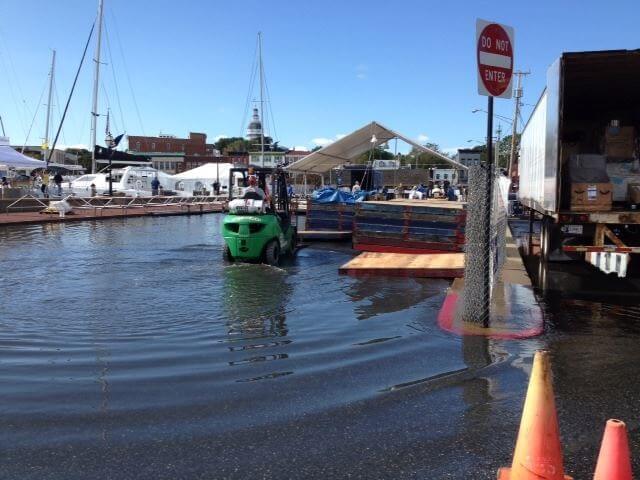Study Shows Dramatically More Flooding in Md.’s Future

Four out of five coastal Maryland communities regularly monitored by the federal government experienced a record number of days of high-tide flooding in 2019, according to a study issued Tuesday. The fifth community withstood its greatest number of high-tide flooding days — a phenomenon where a coastal area floods even if there has been no rain or severe weather — in 2018.
The study, issued by the National Oceanographic and Atmospheric Administration, suggests that an increasing amount of high-tide flooding — often seen as a harbinger of climate change — is almost certain to occur in Maryland and other coastal states in the years ahead. The acceleration is going to begin this year, the agency projects.
“America’s coastal communities and their economies are suffering from the effects of high tide flooding, and it’s only going to increase in the future,” said Nicole LeBoeuf, acting director of NOAA’s National Ocean Service.
Nationwide, coastal communities saw a median flood frequency of four days in 2019, just shy of the record set in 2018. However, 19 locations along the East and Gulf coasts set or tied records, and rapidly increasing trends in high-tide flooding have emerged.
The phenomenon is also known as sunny-day flooding or nuisance flooding and can be exacerbated dramatically by rain storms.
Annapolis saw 18 days of high-tide flooding last year, a record. Also setting records in Maryland last year were Tolchester Beach in Kent County (17 days), Cambridge (11 days) and Solomons Island (11 days). Baltimore City hit its record number of high-tide flooding days — 12 — in 2018, and recorded 11 such days last year.
Twenty years ago, NOAA reported, these communities barely experienced any high-tide flooding. For Cambridge and Solomons Island, it typically happened once a year; in Tolchester Beach and Annapolis, it happened twice a year; and Baltimore City experienced the phenomenon three times a year.
NOAA made projections for high-tide flood days for 2020, 2030 and 2050 — and the problem is expected to grow exponentially.
“As a Chesapeake Bay resident, I see the flooding first hand and it is getting worse. Records seem to be set every year,” said William Sweet, an oceanographer for NOAA’s National Ocean Service and lead author of the report. “Communities are straddled with this growing problem. Fortunately, NOAA’s tide gauge network is keeping a close watch and helping us provide guidance about the disruptive flooding that is likely next year and for decades to come.”
Here are the projections for the five Maryland communities that NOAA monitors:
2020
Cambridge 5-8 days
Tolchester Beach 7-12 days
Baltimore City 5-9 days
Annapolis 6-10 days
Solomons Island 6-9 days
2030
Cambridge 9-20 days
Tolchester Beach 15-25 days
Baltimore City 15-25 days
Annapolis 15-25 days
Solomons Island 10-20 days
2050
Cambridge 40-150 days
Tolchester Beach 50-160 days
Baltimore City 50-155 days
Annapolis 55-170 days
Solomons Island 45-165 days


 Creative Commons Attribution
Creative Commons Attribution